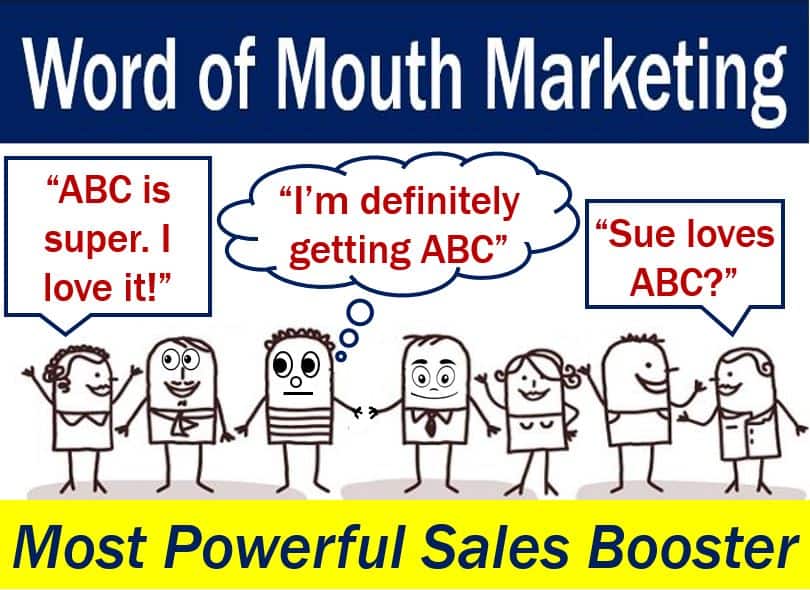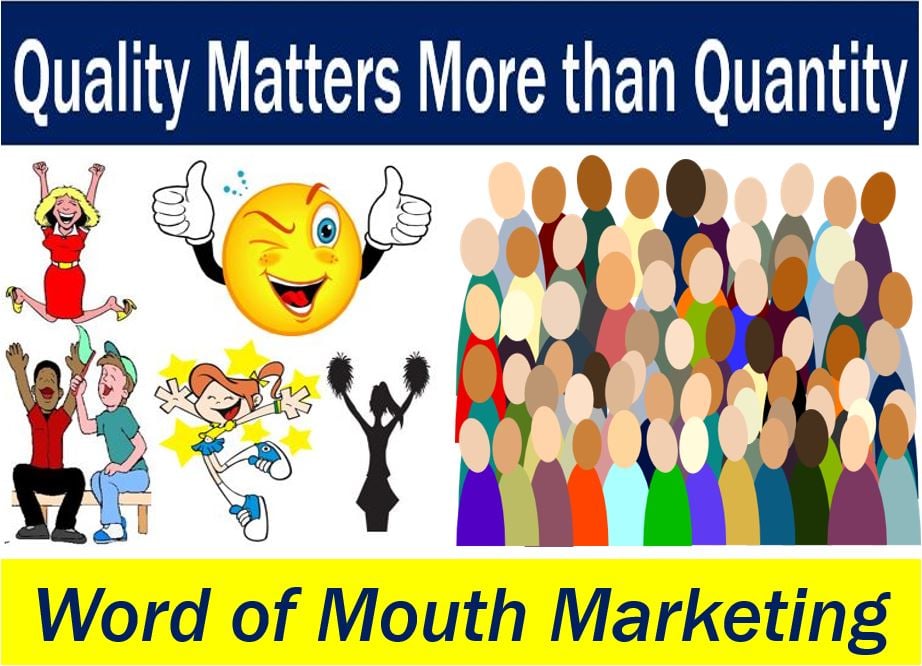Word of mouth marketing – definition and meaning
Word of Mouth Marketing, also called WOMM, is considered the best form of promotion of a brand, product, or service; nothing beats it. It is an oral recommendation by a satisfied customer to other consumers and prospective customers of a brand, product, or service. Even though the term ‘word of mouth’ includes nothing to describe writing, it may also refer to a written recommendation.
The term is often mistakenly used interchangeably with word of mouth advertising. However, for something to be classed as advertising it has to be paid for – with word of mouth marketing, the person giving the recommendation is not being paid.
However, the term ‘word of mouth advertising’ has become so widely used that its meaning, in this sense, must be recognized.
Defenders of good spoken and written English advise people to recognize ‘word of mouth advertising’ when they hear or read it, but to stick to the term ‘word of mouth marketing’ when writing or speaking. In other words, acknowledge it when you come across ‘word of mouth advertising’, but do not say or write the term yourself.
Word of mouth marketing actively encouraged
Companies actively encourage customers to say nice things about their products; in many businesses it is an important function of the marketing department.
Word of mouth marketing differs from naturally-occurring word of mouth, in that the former is actively encouraged. Businesses that just sit back and hope that their satisfied customers will recommend their product or service will lose out to companies that have mastered what has been identified as the most valuable and effective form of marketing.
 Word of mouth marketing is the most powerful booster of sales in the world of business. Companies that best learn to master this important part of marketing are nearly always successful, and have an edge over their rivals.
Word of mouth marketing is the most powerful booster of sales in the world of business. Companies that best learn to master this important part of marketing are nearly always successful, and have an edge over their rivals.
Consumers tend to trust what other consumers say about a company and its products above anything else.
According to Nielsen Holdings PLC, a global information company, ninety-two percent of consumers believe recommendations from peers, friends and family over all forms of marketing or advertising.
In an article that appeared in Forbes, Kimberly A. Whitler wrote the following regarding a WOMMA (Word of Mouth Marketing Association) and AMA (American Marketing Association) study:
“In a recent study, 64% of marketing executives indicated that they believe word of mouth is the most effective form of marketing. However, only 6% say they have mastered it.”
Quality vs. quantity
The problem, Whitler added, is that over the past few years, marketing executives have focused too much on ‘collecting’ and not enough on ‘connecting’. The emphasis has all been on gathering social media fans – they have completely forgotten about actually connecting with them.
Having a hundred or so super-passionate fans who love your product or brand is considerably more effective than having several thousand ‘fans’ who have signed up to win a free tablet or smartphone.
Whitler wrote:
“Just like in life – if you have to buy your friends, are they really your friends? And why should we stop at likes anyway? Why not shoot for LOVE.”
In the past, for marketing executives, it was all about the four Ps: 1. Product. 2. Promotion. 3. Place. 4. Price. Today, the focus needs to be on the 3 Es: 1. Engage. 2. Equip 3. Empower.
Marketers who are able to master the three Es are capable of really making the most of word of mouth marketing, and making their products or services the most beloved and talked about in the marketplace. This will lead to significantly greater sales.

A couple of hundred people who are actively and enthusiastically praising a product are worth much more than thousands who signed up for the chance of winning a prize, but don’t say much.
Word of mouth marketing – history
Word of mouth marketing was pioneered by psychologist George Silverman in the 1970s when he created the telephone focus group – focus groups of people in the same profession.
Silverman noticed that in a focus group comprising physicians, if one or two doctors who were having excellent experiences with a medication told the group about it, their words would significantly sway an entire group of skeptics.
In fact, Silverman was surprised to find that even physicians who had stopped prescribing a drug because of negative experiences were swayed by what the doctors with positive experiences said.
Ever since Web 2.0 came onto the scene, several start-ups like YouTube, MySpace, Digg, and Facebook have used **buzz marketing by combining it with the social networks that they have created.
** Buzz marketing is a viral marketing technique that focuses on maximizing the word of mouth potential of a particular campaign, service or product.
Since the advent of the Internet, word of mouth marketing has exploded – it has become an even more useful and considerably powerful resource for marketers and consumers.
As online word of mouth marketing grew, so did concern that many ‘satisfied customers’ were being paid by the company that supplied the good or service.
In 2005, Commercial Alert, a consumer watchdog group, petitioned the Federal Trade Commission (FTC) in the United States to issue guidelines requiring word of mouth marketers who were paid to disclose their relationship with the company, including a description of the compensation they were receiving.
The FTC today pursues violators of a set of guidelines – penalties include fines and cease-and-desist orders.
The Word of Mouth Marketing Association (WMMA) has an ethics code which states that companies should not pay money to consumers in return for endorsements or recommendations. WMMA has hundreds of members; they all claim to follow the association’s ethics code.
Word of mouth marketing – drawbacks
One of the drawbacks of word of mouth marketing is that the company selling the service or product has little control over when and how this type of promotion occurs.
What customers say might not always be positive. Those with bad experiences can spread those negative sentiments – rather than boosting sales, this will hurt them.
Satisfied customers praising a product or service may be raising expectations to such a point that they are difficult to meet.
Somebody may have bought something because another consumer said lovely things about it. This person may be disappointed.
Consumers who knew nothing about the product are more likely to be satisfied. However, they might never have bought the product in the first place had they not heard or read the recommendation.
One of many types of marketing approaches
Word of Mouth Marketing is one of dozens of different types of marketing strategies or approaches. Let’s have a quick look at ten very popular ones:
- Digital Marketing: Promoting products or services online.
- Content Marketing: Creating valuable content to engage audiences.
- Social Media Marketing: Building brand presence on social media platforms.
- Influencer Marketing: Partnering with influencers for promotion.
- Email Marketing: Sending promotional messages via email.
- Search Engine Marketing (SEM): Using paid ads to increase search visibility.
- Affiliate Marketing: Earning commissions by promoting others’ products.
- Direct Marketing: Direct customer communication for promotion.
- Event Marketing: Using events to promote a brand or product.
- Guerrilla Marketing: Creative, low-cost promotional tactics.
Video – What is Word of Mouth Marketing?
This interesting video presentation, from our YouTube partner channel – Marketing Business Network, explains what ‘Word of Mouth Marketing’ is using simple and easy-to-understand language and examples.

